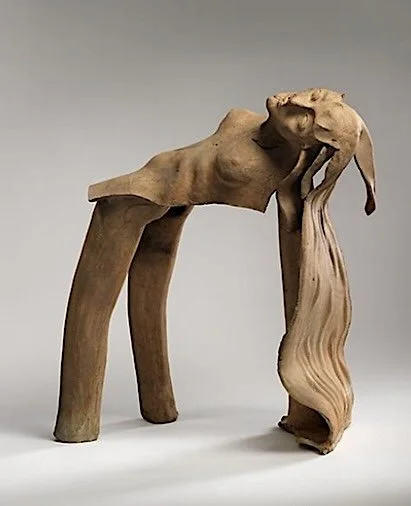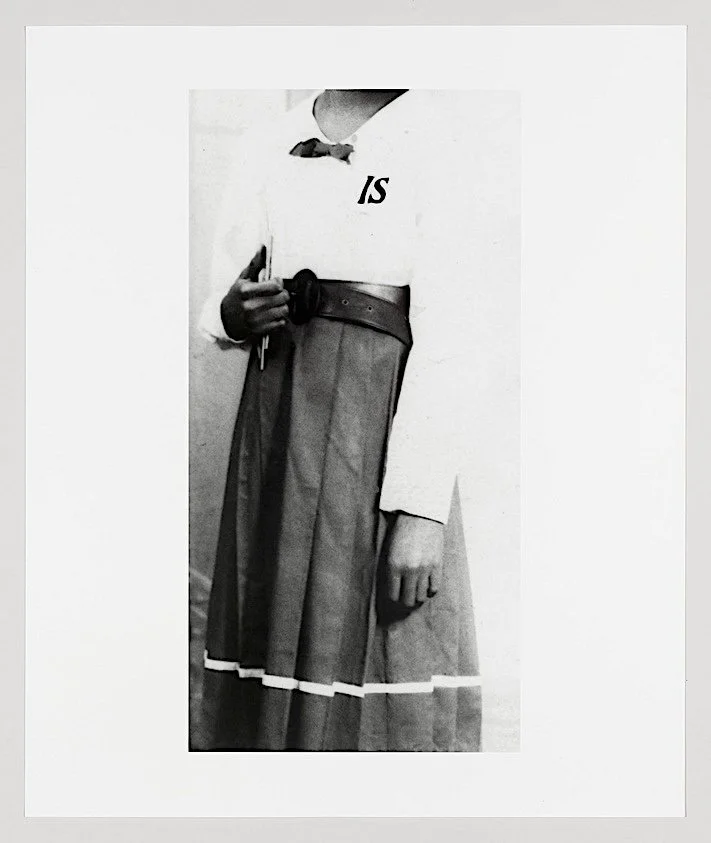Reflections on Annie Ernaux
Becoming a Woman:
Becoming a Woman: Reflections around Annie Ernaux explores the lived, often contradictory passages that shape female identity — from intimate bodily change to the public narratives that name and contain it. The exhibition brings together works of nine women artists that register transition as material practice: memory made visible in paint and textile, threshold moments rendered in found photography and sculptural fragment, and embodied histories told through performance and installation.
October 9 - November 24, 2025
Featured in this Exhibition:
Blanche Serban
Ann Weathersby
Mary Frank
Valerie Belin
Lorna Simpson
Dana Nechmad
Colette Lumiere
Beautiful Dreamer Uniform Series is a couture ensemble composed of a short silk frock and matching leggings, displayed on a dress form at the show’s entrance.
“Colette invented the “Victorian punk.” She often sported an ethereal, feminine look, dripping with lace, tulle, and beads. “‘Victorian punks’ was the perfect combination,” she says. “I actually wore Victorian corsets and bloomers and then I would add a punk element to it. Usually if you saw a punk in those days, they would be wearing black; I would mix it with something very soft.” In retrospect, it’s easy to see echoes of Colette’s signature aesthetic in the goth movement that picked up steam in the ’80s, and in Madonna’s early look during the time of ‘Like a Virgin'”. Geeta Dayal. NPR Magazine, October 21 – 2010
“Colette is a mistress of glamour, long before the current obsession with issues of identity constructions (via Ru Paul, Madonna and Prince). S
“To me, art is like magic, the making of art alchemy, therefore the medium that I use is not as important as the fact that I transform it into art!” Colette – 1978. Colette Lumiere is a trailblazer whose vast and enduring body of work has both innovated and defied the categories of street art, installation, performance, mixed media works, staged photography, and painting from the early 1970s through the present.
Ann Weathersby
Weathersby explains: “Growing up in the conservative yet hedonistic environment in the Deep South in the 1970’s and 80’s – one saturated by objectification, glorification, degradation, and subservience – my impressions of femininity and beauty were, like most, framed by mass culture and societal codes of idealized gender performativity. As a white female born into a history loaded with racism, violence and contradictions, I was expected to be a well-kept caretaker of white myths; to be mannered yet fierce, simultaneously virtuous and sexual. A lens-based artist driven by my love of female writers such as Virginia Woolf, Marguerite Duras, Annie Ernaux, and Clarice Lispector – whose use of language and narrative create a private space for the reader’s autobiography to meld with the protagonists’ – my work coalesces in the realms where gender and sexuality intersect with the personal mythologies we create.
Utilizing images, found and self-authored, pulp paperbacks, text, and kiln-formed glass, I manipulate archetypal symbols of feminine identity and culture through the lens of memory to reveal the power of image culture and language, and the ways in which nostalgia can reinforce these complicated systems of representation. I recontextualize photographs and other temporal media which explicitly or implicitly attempt to visually represent the inner lives of women and femmes..
Elaine Reichek
The Minoans were a European population, descended from the first Neolithic farmers who arrived in Crete from Anatolia around 9,000 years ago, mixing with local populations. Researchers have reconstructed the first biological family tree of a Mycenaean family, revealing kinship structures and burial practices within an ancient hamlet, Science of the Human Past at Harvard.
Even the male protagonists—Zeus, King Minos, the Minotaur, Theseus, Hippolytus—try on a succession of changing and often contradictory roles: father, son, sailor, rapist, seducer, bedfellow, husband. For the artist, the reiterative processes inherent in appropriation, translation, and interpretation are creative acts, and the movements they initiate among languages, disciplines, and materials open possibilities for new readings and meanings.
Minoan Family Tree focuses on the ways in which the Greek myths are continually retold and reenacted over the centuries, in the same way that sewing doubles a thread back upon itself repeatedly.
Embroidery is the perfect vessel for storytelling. Few contemporary artists understand this better than Elaine Reichek, who has explored mediums ranging from painting and drawing to textiles since the 1960s. “Samplers interested me because they combine image and text,” Reichek says. “And because they're identified with women, it's a way of giving them a kind of alternative voice.”










